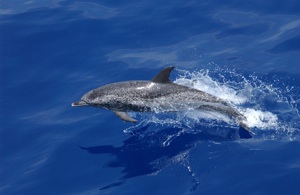Marine Mammal Species Description
Atlantic Spotted Dolphin
Stenella frontalis
(G. Cuvier, 1829)

Photo credit: Wayne Hoggard NOAA/NMFS/SEFSC
Classification
Order: Cetacea
Family: Delphinidae
Alternate Common Names: Bridled dolphin, Gulf Stream spotted dolphin, spotted porpoise
Status: protected under MMPA
Description:
Length: 5.6-7.5 ft (1.7-2.3 m)
Weight: maximum 315 lbs (143 kg)
Atlantic spotted dolphins have a moderate length beak and a visible crease between the melon and their beak. They have a falcate dorsal fin. Atlantic spotted dolphins have a wide variation of coloration depending on where they are. Generally, spotted dolphins are spotted and become more spotted the older they get. Adult spotted dolphins are dark above and white on their belly.
Habitat:
Atlantic spotted dolphins prefer warm waters. They are usually seen in waters around the edge of the continental shelf (approximately 600 ft / 182 m deep). When they are in the Gulf Stream, they can be found much farther from shore and some individuals have been documented in very shallow water. Atlantic spotted dolphins typically occur in schools with less than 50 individuals, but schools can number in the hundreds. They also occur in mixed schools with other cetaceans.
Feeding:
Atlantic spotted dolphins eat fish, squid, and invertebrates. They have been documented cooperatively working within schools herding fish for feeding. Some individuals have been documented eating discarded catch from commercial fishing boats. Typically, Atlantic spotted dolphins dive to depths less than 33 ft (10 m) while feeding, however dives as deep as 200 ft (60 m) have been documented.
Reproduction:
Adult Atlantic spotted dolphins reach sexual maturity at 8-15 years or when the individual reaches approximately 6.5 ft (2 m) in length. This is variable due to the differences in the average length of the two forms of this species (see below). On average, females have one calf every three years. The gestation period lasts for approximately 11.5 months. Females can continue to nurse a calf for up to five years.
Other:
The maximum documented life span for this species is 23 years old.
Distribution / Range:
Atlantic spotted dolphins occur in warm-temperate or tropical waters of the Atlantic Ocean. Off the coast of the eastern United States, two forms can be seen. A larger, more spotted form occurs closer to the coast from the Carolinas south and including the Gulf of Mexico and Caribbean. A smaller form that has fewer and sometimes no spots occurs farther north along the warmer waters of the Gulf Stream.
Similar species:
Similar species include pantropical spotted dolphin (Stenella attenuata).
Notes:
References:
American Cetacean Society. 2004. American Cetacean Society Fact Sheet. http://www.acsonline.org/factpack/SpottedDolphin.htm. Accessed January 2012.
Culik, B. 2010. Odontocetes. The toothed whales: "Stenella frontalis". UNEP/CMS Secretariat, Bonn, Germany. http://www.cms.int/reports/small_cetaceans/index.htm. Accessed January 2012.
Hammond, P.S., Bearzi, G., Bjørge, A., Forney, K., Karczmarski, L., Kasuya, T., Perrin, W.F., Scott, M.D., Wang, J.Y., Wells, R.S. & Wilson, B. 2008. Stenella frontalis. In: IUCN 2011. IUCN Red List of Threatened Species. Version 2011.2. www.iucnredlist.org. Downloaded on 09 January 2012.
Perrin, W.F. 1999. Atlantic spotted dolphin, Stenella frontalis. In The Smithsonian Book of North American Mammals. Wilson, D.E. and S. Ruff, eds., 269-271. Smithsonian Institution in association with the American Society of Mammologists, Washington DC.
Perrin, W.F. 2009. Atlantic Spotted Dolphin - Stenella frontalis . In: Encyclopedia of Marine Mammals 2nd Ed. Perrin W.F., B. Würsig, and J.G.M. Thewissen, eds. Academic Press, New York, pp. 54-56.

 Marine Mammals of Georgia
Marine Mammals of Georgia